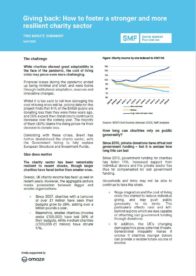The UK’s charity sector has been resilient to recent shocks, but it is unclear how long this can last. This report suggests ways in which government can protect the sector’s long term viability, by instilling long term planning and sustainable financial models.
Key points
- While charities showed great adaptability in the face of the pandemic, the cost of living crisis may prove even more challenging
- The charity sector has been remarkably resilient to recent shocks, though larger charities have fared better than smaller ones
- charities with a turnover of over £1 million have seen their budgets grow by 28%, adding over a billion pounds a year, but smaller charities (income under £100,000) have lost 26% of their budgets
- Since 2010, private donations have offset lost government funding – but it is unclear how long this can last
- Polling evidence finds that 41% of Brits are donating less than they were three years ago, and majority (80%) blame rising inflation for their decision to donate less
Proposed measures to instill long-term planning and sustainable financial opportunities across the third sector include:
- Financial support in the form of a new fund providing competitive grants exclusively to micro and small charities, which often provide services in isolated communities.
- Coordination with the public sector at national, subnational, and local levels to improve service delivery.
- Proportionate regulation should replace existing rules, which would mean cutting red tape for small charities
- Recommendations for the charity sector include
- Investment in an umbrella organisation to help lobby for these policies
- Partnerships with the private sector should be established or improved to increase private sector donations and help meet the market’s ESG demands



